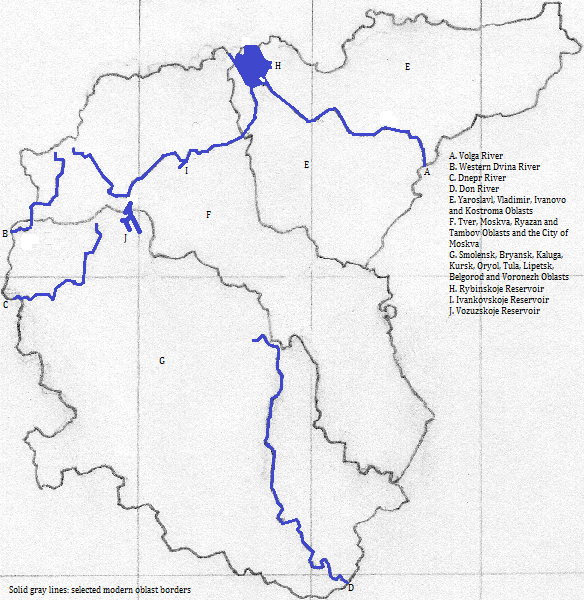
| To Duval Family Home Page | Europe |
| To Chris Home Page | Россия (Rossija or Russia) |
| To Earth (Geography Home Page) | Russophonic-Eurasia |
The Central Federal District
The plateau in the south is the Central Russian Elevation,
In the District's north, and east of the Valdays, the upper Volga's

In 1998 more than 37 million people lived here. Almost 19 in 20 speak Russian as their first language; no other single language accounts for one in 20. Russian Orthodox Christians, in belief or ancestry, account for more than 19 in 20, although aetheists, agnostics and non-practioners are an indeterminate, but large, portion of these. Only one city tops a million: Москва (Moskva), the national and district capital. Other cities of note are Смоленск (Smolensk, also called Smoleńsk), Сергиев Посад (Sergijev Posad or Sergiyev Posad or Sergiev Posad), Владимир (Vladimir) and Ярославль (Jaroslavl' also called Yaroslavl' or Yaroslavl).
The Trans-Siberian Railroad starts in Moskva and goes through Vladimir on its way east; it is a tourist attraction.
UNESCO honors the cultural history of the area through several World Heritage Sites. In Moskva (Moscow) are the Church of the Ascension in Kolomenskoye; the Ensemble of the Novodevichy Convent; and the Kremlin and Red Square. Other sites are the Architectural Ensemble of the Trinity Sergius Laura in Sergiev Posad; the Historic Centre of the City of Yaroslavl; and the White Monuments of Valdimir and Suzdal.
In the first millenium B.C.E., the Iranian-speaking Scythians moved into this area. Their lingering influence today is subtle: toponymy and clay toys, for example.
In the first millenium C.E., eastern Slavonic speakers moved into this area from the east and south. Their initial religion was much influenced by non-Indo-Europeans, and included distinct burial customs, sexual privileges of fathers-in-law
north
east, from the northeast
east, from the center east
east of southern Tambov Oblast and northeast of Voronezh Oblast
southeast and south of Voronezh Oblast
southwest of Voronezh Oblast, south of Belgorod Oblast, southwest of Kursk Oblast, and south of Bryansk Oblast
west of Bryansk and Smolensk Oblasts
northwest of Smolensk Oblast, and west of Tver Oblast
1. Federal Districts were formed in 2000. This one includes Moskva City, its capital; Belgorod Oblast, Bryansk Oblast, Ivanovo Oblast, Kaluga Oblast, Kostromo Oblast, Kursk Oblast, Lipetsk Oblast, Moskva Oblast, Orel Oblast, Ryazan Oblast, Smolensk Oblast, Tambov Oblast, Tver Oblast, Tula Oblast, Vladmir Oblast, Voronezh Oblast and Yaroslavl Oblast.
2. Also transliterated from Russian as Rossiya; Russia in English.
3. Valdajskaja Vozvyšennost' or Valdayskaya Vozvyshennost' in transliterated Russian.
4. Smolensk-Moskovskaja Vozvyšennost' or Smolensko-Moskovskaya Vozvyshennost' in transliterated Russian. They are sometimes labeled as two ridges.
5. Sredne Rossiyskaja Vozvyšennost' or Sredne Rossiyskaya Vozvyshennost' in transliterated Russian.
6. Europe's fourth longest river.
7. Europe's fifth longest river.
8. Europe's longest river.
9. Rybinskoje Vodochraniliščce or Rybinskoye Vodokhranilishche in transliterated Russian. It is perhaps Europe's fourth largest lake.
10. http://www.touropia.com/tourist-attractions-in-russia/, accessed 6/23/2014.
11. According to http://en.wikipedia.org/wiki/White_Monuments_of_Vladimir_and_Suzdal, accessed 6/23/2014, these are the Assumption Cathedral, Golden Gate and Cathedral of Saint Demetrius in Vladimir; the Castle of Andrew the Pius and the Church of the Intersession on the Nerl in Bogolyubovo; the Suzdal Kremlin with the Cathedral of the Nativity, and the Monastery of Saint Euthymius in Suzdal; and the Church of Boris and Glebin in Kidesksha.
12. Basil Dmytryshyn, A History of Russia (Portland State University, 1977).
13. Mircea Eliade, A History of Religions Ideas, Vol. I (University of Chicago Press, 1976).
14. Snochacestvo
15. Elliade, ibid.
16. Germany in English.